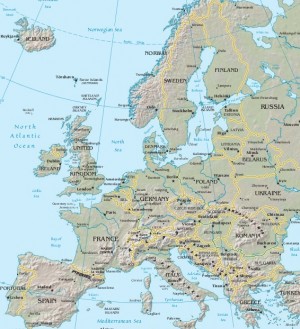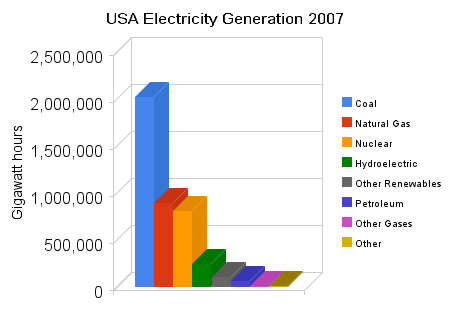Born in the U.S.A.
Recently I wrote about The Falling Fertility of Europe. Now it is the turn of the United States. The U.S. has one of the highest fertility rates in the West. The most recently available fertility statistics from the government are for 2006. Take a look at the table below and then join me in a discussion of what some of the numbers may mean. In the table below Birth rate refers to live births per 1,000 population. Teen birth rate is live births to women aged 15-19 per 1,000 of women aged 15-19 in the population. Fertility rate is live births per 1,000 women aged 15-44 years. The TFR (Total Fertility Rate) of a population is the average number of children that would be born to a woman over her lifetime. Bear in mind that the replacement fertility rate is roughly 2.1 births per woman for most industrialized countries.
Highs and Lows
By sorting the TFR column we can see that 25 states have a Total Fertility Rate of 2.1 or higher. This is the replacement rate of the population. Of course because of immigration the population is increasing. Through the sort we can also see that Vermont has the lowest TFR and Utah the highest. Why is this? In Utah the high birth rate is undoubtedly due to the high percentage of Mormons in the state, who tend to have larger families. Vermont’s low birth rate, according to the Times Argus, is attributed to its racial homogeneity and high education levels among women — factors not easily changed by government intervention. Hispanic women, who comprise less than one percent of the state’s population, statistically have higher birth rates.
The Problem of Low Birth Rates
Consider what the Vermont Governor Douglas has to say:
Employers cite adequacy of the workforce as one major concern for future success here. We have employers who have created good jobs and want to create more, but they need a qualified workforce to take those jobs.
In the last year the number of people in Vermont’s workforce fell by 2,000. The low birth rate is a component of a much bigger problem. The median age of Vermont’s workforce, at 42.3 years old, is the highest in the nation. In the next twenty years the workforce is expected to shrink annually as those wage-earners reach retirement age. Because surrounding states also have low birth rates the competition for a shrinking pool of workers will become intense.
United States 2006 Fertility Rates by State
Click ONCE on column headers to sort.
| State | Birth rate | Teen birth rate | Fertility rate | TFR |
|---|---|---|---|---|
| United States | 14.1 | 41.4 | 68.4 | 2.10 |
| Alabama | 13.7 | 53.5 | 67.0 | 2.03 |
| Alaska | 16.4 | 44.3 | 76.7 | 2.32 |
| Arizona | 16.6 | 62.0 | 81.6 | 2.44 |
| Arkansas | 14.6 | 62.3 | 72.2 | 2.18 |
| California | 15.4 | 39.9 | 71.8 | 2.18 |
| Colorado | 14.9 | 43.8 | 70.2 | 2.11 |
| Connecticut | 11.9 | 23.5 | 58.8 | 1.90 |
| Delaware | 14.0 | 41.9 | 67.3 | 2.09 |
| District of Columbia | 14.7 | 48.4 | 58.4 | 1.70 |
| Florida | 13.1 | 45.2 | 67.3 | 2.09 |
| Georgia | 15.9 | 54.2 | 72.4 | 2.23 |
| Hawaii | 14.8 | 40.5 | 73.9 | 2.23 |
| Idaho | 16.5 | 39.2 | 80.9 | 2.42 |
| Illinois | 14.1 | 39.5 | 66.8 | 2.03 |
| Indiana | 14.0 | 43.5 | 68.3 | 2.08 |
| Iowa | 13.6 | 32.9 | 69.1 | 2.14 |
| Kansas | 14.8 | 42.0 | 73.3 | 2.23 |
| Kentucky | 13.8 | 54.6 | 67.1 | 2.05 |
| Louisiana | 14.8 | 53.9 | 70.6 | 2.11 |
| Maine | 10.7 | 25.8 | 54.5 | 1.77 |
| Maryland | 13.8 | 33.6 | 64.2 | 2.01 |
| Massachusetts | 12.1 | 21.3 | 56.9 | 1.78 |
| Michigan | 12.6 | 33.8 | 61.7 | 1.93 |
| Minnesota | 14.2 | 27.9 | 68.7 | 2.14 |
| Mississippi | 15.8 | 68.4 | 75.7 | 2.26 |
| Missouri | 13.9 | 45.7 | 67.9 | 2.06 |
| Montana | 13.2 | 39.6 | 69.5 | 2.13 |
| Nebraska | 15.1 | 33.4 | 75.1 | 2.29 |
| Nevada | 16.0 | 55.8 | 77.9 | 2.36 |
| New Hampshire | 10.9 | 18.7 | 53.4 | 1.75 |
| New Jersey | 13.2 | 24.9 | 64.5 | 2.05 |
| New Mexico | 15.3 | 64.1 | 74.7 | 2.23 |
| New York | 13.0 | 25.7 | 61.1 | 1.89 |
| North Carolina | 14.4 | 49.7 | 69.0 | 2.13 |
| North Dakota | 13.6 | 26.5 | 68.7 | 2.14 |
| Ohio | 13.1 | 40.0 | 64.7 | 1.99 |
| Oklahoma | 15.1 | 59.6 | 74.7 | 2.20 |
| Oregon | 13.2 | 35.7 | 65.4 | 1.96 |
| Pennsylvania | 12.0 | 31.0 | 60.6 | 1.93 |
| Rhode Island | 11.6 | 27.8 | 54.6 | 1.72 |
| South Carolina | 14.4 | 53.0 | 69.6 | 2.14 |
| South Dakota | 15.2 | 40.2 | 78.5 | 2.40 |
| Tennessee | 14.0 | 54.7 | 67.5 | 2.07 |
| Texas | 17.0 | 63.1 | 78.8 | 2.36 |
| Utah | 21.0 | 34.0 | 94.1 | 2.63 |
| Vermont | 10.4 | 20.8 | 52.2 | 1.69 |
| Virginia | 14.1 | 35.2 | 66.3 | 2.05 |
| Washington | 13.6 | 33.4 | 65.2 | 1.98 |
| West Virginia | 11.5 | 44.9 | 59.4 | 1.82 |
| Wisconsin | 13.0 | 30.9 | 64.0 | 2.01 |
| Wyoming | 14.9 | 47.3 | 75.9 | 2.24 |
.
Higher Teen Birth Rates
2006 saw significant increases of teen birth rates in 26 states. My table doesn’t show previous year’s statistics but an article in USA Today has a useful map comparing 2005 with 2006. Some blame the increase on a more sexualized culture and greater acceptance of births to unmarried women. Others say abstinence-only sex education and a possible de-emphasis on birth control may play a part. According to USA Today, Sarah Brown, CEO of the National Campaign to Prevent Teen and Unplanned Pregnancy, says she is less inclined to believe abortion is driving higher teen birth rates and suggests that increases in high-profile unmarried births in Hollywood, movies and even politics is a significant factor for impressionable teens. Sarah says:
In the last couple of years, we had Jamie Lynn Spears. We had Juno and we had Bristol Palin. Those three were in 2007 and 2008 and not in 2005 to 2006, but they point to that phenomenon.
Total Fertility Rate Details
The TFR was 2.1 births per woman in 2006, a two percent increase compared with 2005 (2.05) and the highest reported since 1971 (2.27). This is the first year the U.S. TFR has been above replacement since 1971. From 1990 to 1997, the TFR decreased substantially (from 2.08 to 1.97), but has generally increased since 1998. The increase in the TFR in 2006 reflects the increase in birth rates for nearly all age groups, especially for those women aged 15–19 and 20–24 years. The TFR also increased for nearly all race and Hispanic origin groups between 2005 and 2006 with the rate increasing 1 percent for non-Hispanic white, 3 percent for Hispanic, and 5 percent for non-Hispanic black women. (Source: National Center for Health Statistics PDF)
Summary
If not for immigration, the U.S. population would merely be replacing itself. In future years the birth rates will likely be declining, along with world birth rates in general. Because many have been indoctrinated with the “population explosion” myth it will be difficult to convince sufficient numbers that there is even a problem with low birth rates. What is required is an emphasis on family and the preciousness of children. Governments need to be friendly towards traditional marriage and encourage all to support family life.
External Articles
This list is updated occasionally, with newer additions listed first.
Census: Number of U.S. youth shrinks — Decline of more than 260,000 from 2010.
U.S. population grows at slowest rate since 1940s — A growth rate of 0.92 percent.
A Connecticut Town Adjusts to a Graying Population — Connecticut’s median age was 40 in 2010.
Is economy best birth control? US births dip again — Total Fertility Rate fell to 1.9 children.
Will the housing bust produce a baby bust? — A likely contributor to a baby bust.
Older Populations Soar as Age Trend Accelerates — Eastern and “rust belt” areas are aging rapidly.
Census reveals plummeting U.S. birthrates — There are now more households with dogs than children.
Where have all the children gone? — Number of kids declining across the country.
Census: New Hampshire population aging, growing — Median age jumps from 37 to 41.
The Baby Bust of 2009 in the United States — Births fell from 4,316,233 (2007) to 4,131,019 (2009).
Driven by the Recession, a Baby Bust Hits the U.S. — Threatens already-strained social programs.
Report: U.S. births hit all-time high — More babies in 2007 in the U.S. than ever before.
Babies — Expensive, Intrusive and Too Few for the Economy — $286,000 per baby.
3 Utah metro areas among fastest growing in U.S. — Utah’s continuing baby boom credited.
Birthrate drops in multiple states — Pregnancy falloff began months before economy’s troubles.
Population drop-off vexes Maine residents — Stems mostly from young people leaving.
The Family: The Hope for the Future of Nations — Happiness and the future is linked to children.
U.S. Birth Rate Decline Linked to Recession — An analysis of state fertility.
400 Million People Can’t Be Wrong — Why America’s new baby boom bodes well for our future.










